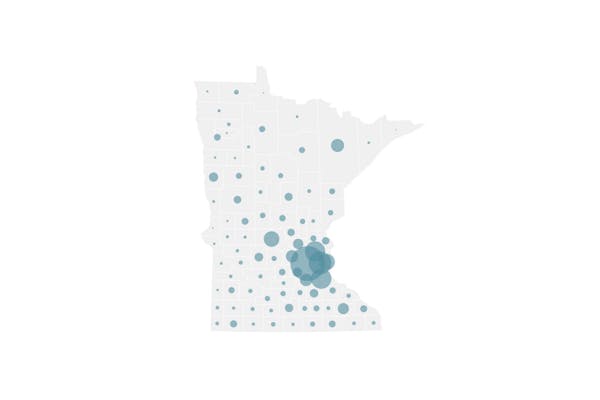New Minnesota COVID-19 cases surged Friday to hit a record-setting 2,297 infections, 50% higher than the previous daily peak set just last Saturday.
The jump came on a significant increase in testing volume, with 44,398 samples analyzed for the new coronavirus, also a new daily record.
"I am very saddened and frankly deeply worried about today's number but I am not surprised," said Minnesota Health Commissioner Jan Malcolm.
The upsurge in testing, which state officials said was not tied to any large testing events or a response to clusters, explains part of the growth in cases, which have now reached a total of 119,396.
While state epidemiologists have not yet interviewed all those who have been recently infected, the case growth so far doesn't appear to be driven by any particular group or region.
"We are seeing high COVID numbers across the state in multiple locations," said state infectious disease director Kris Ehresmann. "This is just unfortunately widespread transmission of COVID in Minnesota."
Infections among those in their 40s or 50s were both up 4%, while cases among those in their 20s — one of the fastest growing age cohorts, went up 3%. The rising tide concerns health officials, who point to growth in hospitalizations and deaths and the potential to shrink the available health care workforce due to exposures and infections.
Although case growth here lags behind increases in neighboring states, Minnesota has reported more than 1,000 new cases for 12 of the past 16 days, Malcolm noted.
With about 12,000 known active COVID-19 cases, more people are requiring hospitalization for disease complications and deaths are reaching levels not seen since mid-July.
There were 91 fatalities reported over the past week, including 13 announced Friday, bringing the pandemic's state death toll to 2,212. Six of the deaths were among residents of long-term care facilities.
Hospitals are caring for 484 COVID-19 patients, including 126 requiring intensive care. Preliminary data show 464 new admissions this week. Although that is a 17% decrease from the prior week, hospitals have been taking in more than 300 cases each week since mid-September.
"The new daily admissions to the hospital and ICU clearly are trending upward," Malcolm said. "This tells us that more people are being more severely impacted by COVID-19."
COVID-19 is spreading more widely from social gatherings and activities, rather than in public places such as retail stores or workplaces, Minnesota health officials said.
Malcolm speculated that people are more likely to let their guard down among family and friends. Because the virus can be spread even by those who don't have symptoms, many people are unknowingly infecting others.
"It spreads when you don't feel it. It spreads when you don't know it," she said.
The widespread community transmission means that more health care workers are getting exposed. Even if they test negative, workers with high-risk exposures need to quarantine for 14 days because the disease's long incubation period means they might test positive later.
"Bed capacity is not our challenge in Minnesota, it is keeping our hospitals and health care systems staffed," said Jennifer DeCubellis, chief executive at Minneapolis-based Hennepin Healthcare.
In May, 18% of all high-risk COVID-19 exposures among workers in acute care and outpatient clinics were traced to patients, with 24% happening in social or household settings, Ehresmann said.
But in September, 8% of exposures came from patient contact, while 62% were from social or household settings.
"As health care providers we can't save lives and care for those who are sick if our own workforce is exposed in the community," DeCubellis said.
In long-term care settings, recent cases among staff workers increased 15%, compared to a 10% increase among residents, according to Health Department data released earlier this week.
The Minnesota National Guard has been called in to help contain outbreaks at two nursing homes where staffing levels had been depleted.
COVID-19 is most likely to seriously affect those with underlying health conditions, including heart, lung and kidney diseases, as well as diabetes and obesity.
Many people who become sickened recover without medical intervention.
Since the pandemic began, 105,120 of those infected are considered to be no longer infectious and do not need to be isolated.
Although the daily case counts, testing numbers and deaths can make headlines, they most often paint a picture of developments that happened over the past several days, if not weeks.
For instance, of the 2,297 new cases announced Friday, only 11 of the positives were from samples collected Thursday.
Most of Friday's new cases stemmed from 929 swabs collected last Monday, meaning it took three days for the results to be reported to the Health Department. Another 692 cases were from tests last Tuesday.
Given that it can take two weeks for a test to detect an infection, many of the cases announced Friday could represent infections that happened weeks ago.
Glenn Howatt • 612-673-7192
2 dead in Lino Lakes, no known threat to public, police say
Teen charged with murder in deadly St. Paul shooting last month

Clash brewing over Lino Lakes development plan that includes mosque
Minneapolis City Council declines to endorse Frey's Third Precinct plan

